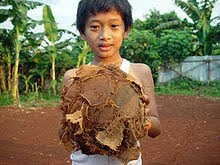Dr. Abe V. Rotor
Living with Nature School on Blog
Paaralang Bayan sa Himpapawid (People's School-on-Air) with Miss Grace Velasco
738 DZRB AM Band, 8 to 9 evening class Monday to Friday
Lesson: Building toys is indeed a manifestation of intelligence and revelation of a hidden talent. With changing time and life style, what really are toys for? After reading this lesson, write an essay on Functional Toys – A Revolution in Toys.



Abraham Lincoln's Log Cabin - original and miniature model
When I saw a film about suspending Christmas in America during the First World War, I thought that the idea was good. For how can a nation at war afford to manufacture toys, celebrate Christmas at home when thousands of its citizens are out there in the battlefield? So the campaign was – No Christmas, No Toys. At least temporarily until the war is over. So toy companies went into manufacturing arms and war materiel, people were told to buy bonds, not toys. Logical isn’t?
Until the president of one of America’s biggest toymaker AC rallied against the campaign and before the US Congress closed for the Christmas, he convinced the body to re-consider the campaign. So convincing was his approach by showing toy models that the President himself lifted the No Christmas, No Toys Campaign that very Christmas.
What was AC’s selling point? First, he rode on the foundation of American culture that gives importance to important events and celebrations. But the key was his revolutionary concept of toys. Toy models that stir the mind of the young to associate themselves with issues, to stir imagination and invention: learning toys.
Let's consider the functions of toys.
1. Toys can help children to learn – learn positively and functionally, meaning toys that have applied value; toys that can increase functional literacy.
2. Toys can tap inventive skills - Not toys that merely stimulate curiosity. By so doing, toys are dismantled and eventually destroyed without satisfying curiosity itself – much less added to basic and functional knowledge. Many inventions started as toys. Examples: pendulum of a clock, gyroscope of airplane, electromagnet in metal industry.
cmpass 3. There are sorts of toys, irrespective of status in life. What should be the toys of the poor, the children in marginal communities? Are there toys that can help them in their plight – at least ultimately, in one way or the other. If there are toys of this kind, what are their special features? Principle of a push cart. Building a house (bahay bahayan).
4. Differentiate toys from gadgets, say a cell phone or computer? Computer games need re-classification. Explain what is mere entertainment from a functional toy.
5. Electric and electronic devices have taken out the quaintness and challenges of conventional of toys. But you can ingeniously modify them. Toys should be learning tools. Toys should not deprive our children of their time to play, to attend to their hobbies, and to be at the playground or in the countryside with nature.
6. Devise games that teach children values. Games that do not only make us aware of our responsibilities as citizens but as members of the living world – as ecologists or environmentalists.
7. Know what to do with your toys after you have used them, or outgrown them. There are toys for recycling. Are they transformable in the sense that they can be useful again with the lesson they carry? Should toys be permanent or at least lasting?
8. Toys create a healthy archetype which children will use as tool when they grow up. Can toys be shared with adults and therefore the lessons are likewise commonly shared – lessons that are useful in strengthening values, in building skills, etc.?
Knife collection is never outgrown to many people who love the wildlife.
9. There are toys worth keeping for a life time. There are toys that remind us of our childhood even when we shall have grown very old. Remember Maria in Sound of Music sing My Favorite Things.
10. Express love on living toys? Unlike rhinoceros beetles in tug-of-war, and spider (gagambang hari) gladiators, we can culture butterflies in our garden, build nest for transient birds.
11. Toys promote universal values, such as preservation and exchange of cultures, cooperation, brotherhood and peace. Toys are agents of peace and understanding.
12. Toys are investments, they make a wholesome enterprise. No country or organization has the monopoly of toys.
Does a toy lead to invention?
I noticed a sign on an assembled motor car, "Toy for big boys." Remember the solar powered car made by De La Salle boys which caught world attention? Earmuff was invented by a boy, so with the stethoscope.
There are inventions miniaturized into toys. These become teaching models and learning aids. I visited the miniaturized city of Madurodam in the Netherlands. Everything is a miniaturized version of say, the Eiffel Tower, the Pyramids, the Himalayas. Madorodam is a one-hectare site of thousands of famous buildings, personalities, landcapes, events,and the like. It is a sprawling sand table.
Toys are as universal as the language of music; they are the language of children, and people who nurture precious childhood. Toys are great teachers. They are the key to world peace.~



No comments:
Post a Comment